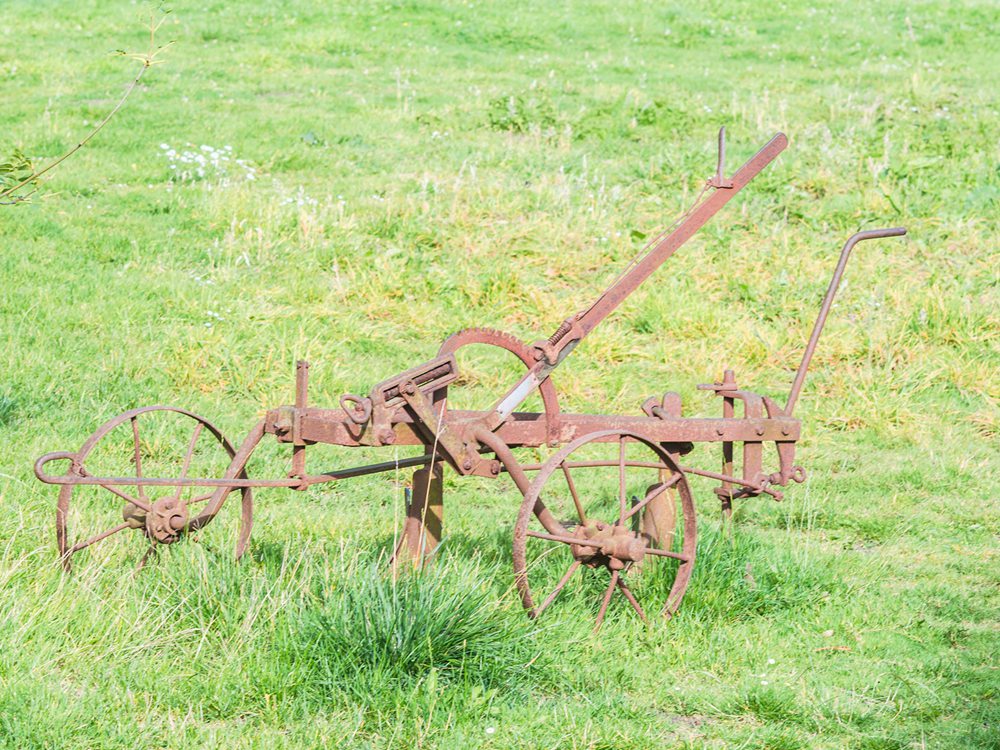Antique plows hold a special place in the history of agriculture, representing a time when farming was done manually or with the help of animals. As a collector or an enthusiast, it’s essential to know how to identify and value these fascinating tools. In this guide, we will walk you through the process of how to recognize different types of antique plows and assess their value.
First, let’s explore the three main types of antique plows: walking, animal-drawn, and tractor-drawn. Each type has unique features and value factors to consider. Then, you’ll learn about the importance of the plow’s age, material, and brand when determining its worth. By understanding these elements, you’ll be better equipped to recognize and appraise antique plows in your collection or the ones you may come across in your search.
Armed with this knowledge, you’ll not only be able to appreciate the craftsmanship and historical significance of these antique plows but also make informed decisions when buying or selling them. So, let’s dive into the world of antique plows and discover the stories they hold and the values they carry.
Table of Contents
History of Antique Plows
First Plows
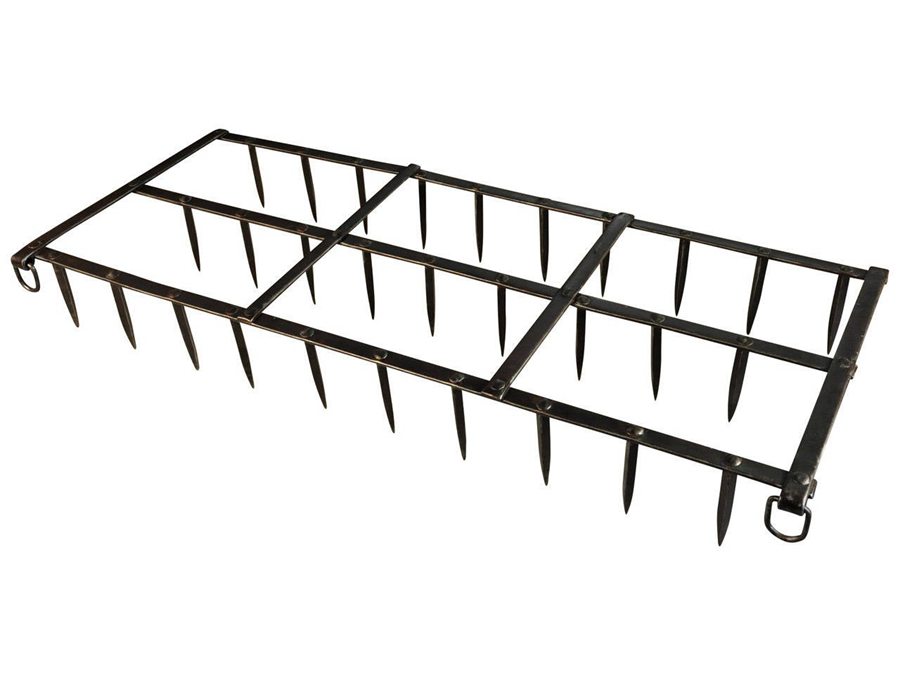
The history of antique plows dates back to the early days of agriculture when basic tools were used for tilling the soil. The first plows were simple, consisting of a stick and an iron digger that were crafted by local blacksmiths or carpenters. These early plows from the 1750s are now valued as high as $8,000 due to their hand-joint finishes and high-duty materials.
Walking Plow & Their Valuation
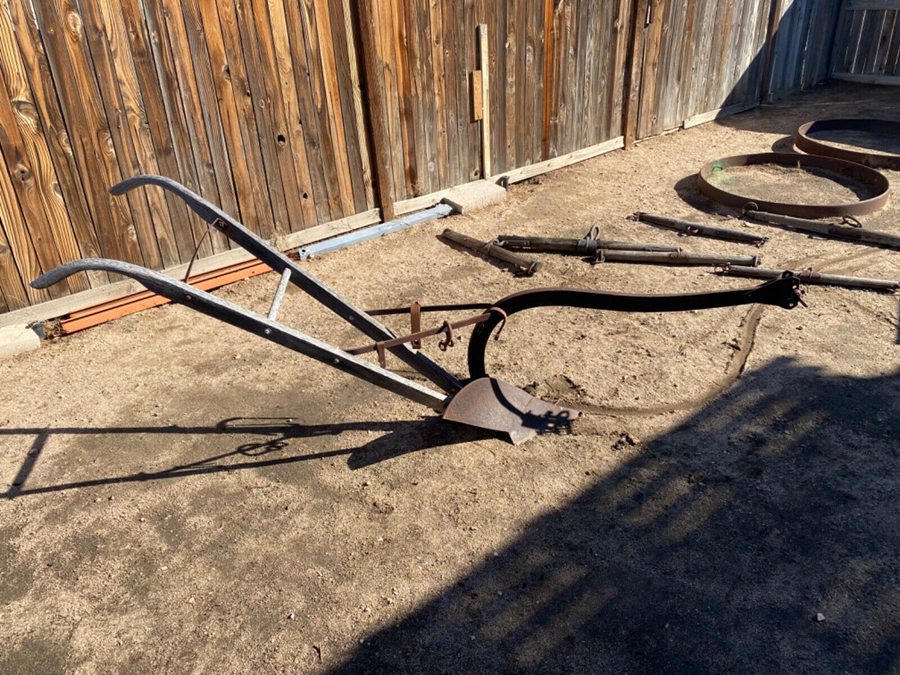
In the 1800s, walking plows became popular as they allowed farmers to till the soil more efficiently. These triangular-shaped plows had a single piece of wood for the body and were fitted with wheels at the front to keep them moving. The wooden handles of walking plows made them comfortable to use, and their rarity and design have made them valuable collectors’ items.
| Old Plow Name | Manufacturer | Antique Plow Type | Average Valuation |
|---|---|---|---|
| 8-Bottom Land Plow | John Deere | Walking Plow | $8000 – 9000 |
Horse-Drawn Plow & Their Valuation
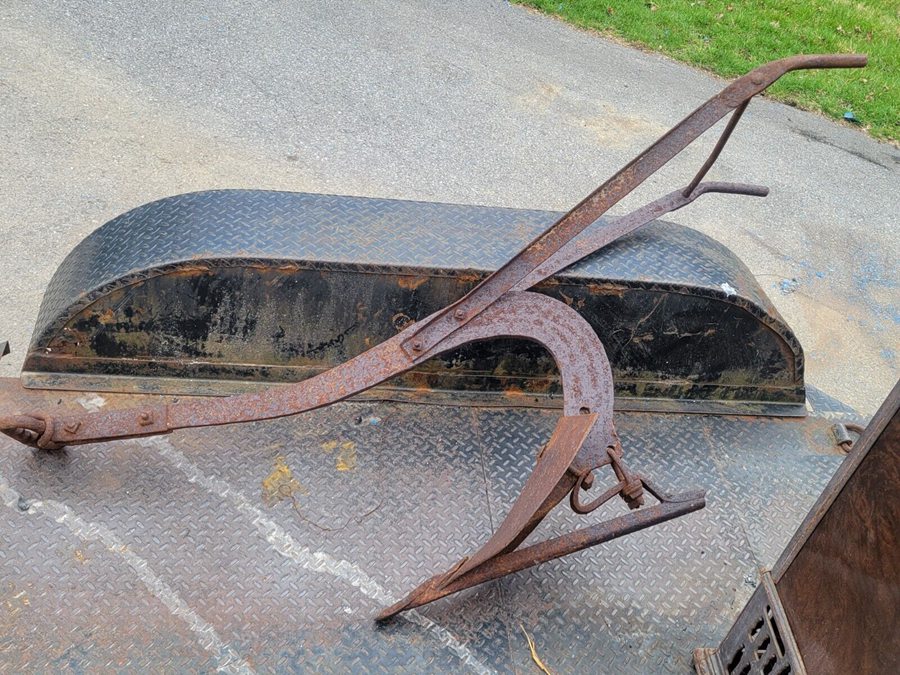
The development of the horse-drawn plow significantly changed the world of agriculture. Horses provided more power and speed, allowing farmers to cover larger areas in a shorter amount of time. The antique horse-drawn plows remain a valuable piece of history, showcasing the ingenuity of their design that evolved to accommodate the use of horses for farming.
| Old Plow Name | Manufacturer | Antique Plow Type | Average Valuation |
|---|---|---|---|
| Two Plow Plow | Parlin & Orendorff | Horse-Drawn Plow | $3000 – 4000 |
Cattle-Drawn Plow & Their Valuation
Cattle-drawn plows, which were used before the introduction of horses, were designed with larger, more sturdy triangular structures. The use of cattle allowed farmers to work in larger fields and improved the efficiency of cultivating land. These antique cattle-drawn plows are valued for their historical significance and unique designs.
| Old Plow Name | Manufacturer | Antique Plow Type | Average Valuation |
|---|---|---|---|
| 2-Bottom Land Plow | Oliver | Cattle-Drawn Plow | $1000 – 1500 |
As a collector or enthusiast, understanding the history and valuation of these antique plows allows you to better appreciate their contribution to the evolution of agriculture and farming practices.
Types of Antique Plows
Moldboard Plows & Their Valuation
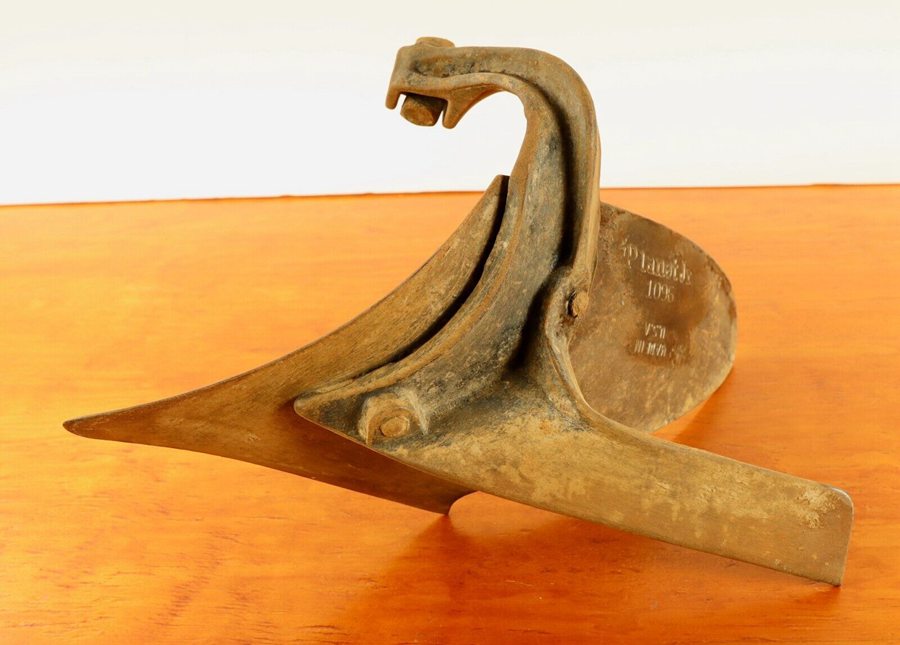
Moldboard plows were commonly used in agriculture to turn over the soil and prepare it for planting. They consist of a curved, vertical blade called the moldboard that cuts into the ground, turning the soil as it goes. Moldboard plows can be found in various forms, such as walking plows, horse-drawn plows, and ride-along plows.
Here is a price table to give you an idea of the valuation for some antique moldboard plows:
| Old Plow Name | Manufacturer | Antique Plow Type | Average Valuation |
|---|---|---|---|
| Bottom Switch Plow | John Deere | Moldboard Ride-Along Plow | $5500 |
| 8-Bottom Land Plow | John Deere | Walking Plow | $8000 – 9000 |
| Two Plow Plow | Parlin & Orendorff | Horse-Drawn Plow | $3000 – 4000 |
| 2-Bottom Land Plow | Oliver | Cattle-Drawn Plow | $1000 – 1500 |
China Iron Plow & Their Valuation
The China Iron Plow was an early type of plow made from iron and wood, initially used in ancient China. It was designed to be drawn by horses or oxen, and it effectively broke up clumps of soil and leveled the ground. As these plows are relatively rare, their valuation can significantly vary. It’s essential to consult an expert to determine the true value of a specific China Iron Plow.
Antique Garden Plow & Their Valuation
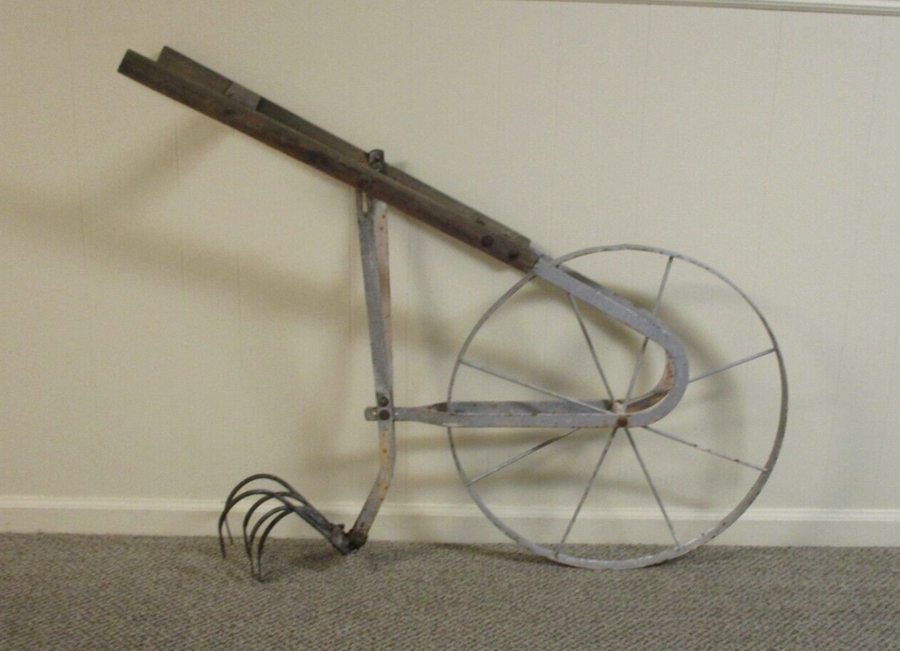
Antique garden plows are smaller than field plows and were typically used for cultivating soil in home gardens or small farms. There are a few common types, like the Harrow Plow and Cultivator Plow. The Harrow Plow is designed for breaking up clumps of soil and leveling the ground, while the Cultivator Plow is used to incorporate organic matter and remove weeds.
The value of antique garden plows depends on factors such as age, condition, and rarity. It’s crucial to research the specific type and manufacturer of the garden plow to determine its valuation accurately. Consulting an expert or using a trusted price guide can also be helpful.
By understanding the different types of antique plows and their valuation, you can build your knowledge to accurately identify and value these fascinating pieces from a bygone era.
Factors to Identify & Value an Antique Plow
Look and Condition
When identifying and valuing an antique plow, one of the first things to consider is its overall look and condition. Examine the plow for signs of wear, rust, and damage, as these factors can significantly impact the value of the piece. A well-preserved plow is more likely to command a higher price than one that is damaged or visibly deteriorated. Note the following aspects:
- Materials used: Antique plows were typically made from wood and metal, so look for a combination of these materials.
- Paint or finish: Original paint, varnish, or patina can be an indicator of age and contribute to the plow’s value.
Manufacturer’s Mark
Another crucial factor in identifying and valuing an antique plow is the presence of a manufacturer’s mark. Many agricultural equipment manufacturers, such as John Deere, International Harvester, and Oliver, produced plows that are now considered antiques. Check for any markings or logos that can indicate the plow’s maker, as this can greatly influence its value. Here are some tips:
- Look for engraved or stamped marks on the metal, especially near joints or attachments.
- Research the manufacturer’s history to determine the age and rarity of the plow, which can affect its value.
Historical Ties
Finally, consider any historical ties that can add to the plow’s significance and value. Antique plows with documented connections to significant events, places, or individuals can be more valuable than those without such ties. To establish a historical connection:
- Research the plow’s provenance, or ownership history, to uncover any interesting or noteworthy past owners.
- Explore the plow’s potential ties to historical farming practices, locations, or events, such as the Dust Bowl or the development of modern agriculture.
By considering the look and condition, manufacturer’s mark, and historical ties of an antique plow, you can better determine its worth and importance in the world of antique agricultural equipment.
Value and Pricing Guide
Reference Materials
To understand the value of antique plows, it’s crucial to have a solid understanding of their history, types, and designs. Research into books, articles, and online resources can provide valuable insights. Check websites and forums dedicated to antique farm tools and seek advice from experienced collectors. This knowledge will help you identify and accurately appraise antique plows.
Auction Results
Keeping an eye on auction results for antique plows can give you a good idea of the market prices. Pay attention to the details, such as the condition and rarity of the plow, as well as the final bid prices. This information will help inform your understanding of the value of your antique plow. Keep in mind that auction results for similar plows can vary significantly, as each piece is unique.
Collector’s Advice
Engaging with collectors who have experience with antique plows can offer valuable insights into pricing and valuation. Like with reference materials, forums and clubs are excellent places to find knowledgeable collectors willing to share their expertise. Be open to their suggestions and advice, as they can help you make the most informed decisions when appraising your plow.
Price Guide
In general, antique plows can be valued between $100 and $700. The vast majority of these plows are usually priced between $100 and $300. However, a few factors may influence their value:
- Type and Design: Different types of plows, such as walking plows, will have different values. The design and features of a plow can impact its worth as well.
- Condition: A well-maintained antique plow in good working condition will fetch a higher price than one that is damaged or has missing parts.
- Rarity: Unique or rare plows will often garner higher values due to their scarcity on the market.
Here’s a basic price range for common antique plow types:
| Plow Type | Price Range |
|---|---|
| Walking Plow | $100 – $300 |
| Horse-Drawn | $200 – $500 |
| Tractor Plow | $300 – $700 |
Keep in mind that these are general guidelines for pricing and may not be applicable in every situation. Consult multiple sources and experts for a more accurate appraisal of your antique plow.
Restoration and Reproductions
Paint and Preservation
When restoring antique plows, it’s crucial to consider paint and preservation techniques. The proper paint application can enhance the plow’s aesthetics and protect it from further deterioration. To achieve this, you should:
- Clean the plow thoroughly, removing any rust and dirt.
- Prime the plow’s surface with a rust-preventative primer to ensure a long-lasting finish.
- Apply a high-quality enamel paint appropriate for metal surfaces. Make sure to choose a color that matches the original paint or complements the plow’s design.
Don’t forget about the preservation of wooden components. Treat wood with wood preservative and sealant to protect it from rot and insect damage. In some cases, replacement of deteriorated wood may be necessary – try to use wood that closely matches the original in appearance and properties.
Authenticity Verification
To ensure you’re working with an authentic antique plow rather than a reproduction, it’s essential to verify its authenticity. This can be done by:
- Examining the materials: Authentic antique plows typically feature cast iron, wrought iron or wood. If you notice materials like plastic or aluminum, it’s likely a reproduction.
- Looking for manufacturer’s markings: Many antique plows will have the manufacturer’s name, model number, or patent information stamped or engraved on them.
- Assessing wear and aging: A genuine antique plow will show signs of use and age, such as worn edges, uneven surfaces, and patina formation.
- Consulting with experts: If you’re unsure about a plow’s authenticity, seek advice from knowledgeable collectors, dealers, or appraisers.
Keep these restoration and reproduction tips in mind as you work to bring new life to your antique plows. Remember, proper care and maintenance will ensure their continued value and enjoyment for years to come.
Buying and Selling Antique Plows
Getting Your Plow Valued
Before you consider buying or selling an antique plow, it’s essential to determine its value. To do this, you can:
- Check auction records to see how much similar plows have sold for in the past
- Consult price guides and reference books for information on antique plow values
- Talk to other collectors and antique dealers to get their opinion on your plow’s worth
Remember that factors such as age, condition, rarity, and provenance will impact a plow’s value. Most antique plows are priced between $100 and $300, but special cases can fetch much higher sums.
Where to Buy an Antique Plow
If you’re looking to buy an antique plow, consider exploring these options:
- Local antique stores: Start with your local antique dealers, as they may have a selection of antique plows or be able to direct you to other sources
- Flea markets and garage sales: Don’t underestimate the potential to find a hidden gem at a local flea market or garage sale
- Online marketplaces: Websites like eBay, Etsy, and specialized antique forums can be great places to find antique plows for sale
Flea Markets and Garage Sales
When visiting flea markets and garage sales, keep these tips in mind:
- Arrive early to have the best selection of items and the chance to negotiate prices
- Always inspect the plow carefully for signs of damage, rust, or tampering that may affect its value
- Bring a price guide or use your smartphone to quickly reference prices online
- Don’t be afraid to negotiate! It’s common practice at flea markets and garage sales
Online Marketplaces
Buying antique plows online has its advantages and challenges. Here are some pointers to help in your search:
- Carefully review the seller’s description and photos to assess the plow’s condition and authenticity
- Make use of search filters and keywords to narrow down the results
- Check the seller’s reputation, ratings, and reviews to ensure they’re trustworthy
- Consider shipping costs and potential risks associated with transporting a fragile antique plow
By being diligent in your research, valuation, and buying process, you can successfully acquire and sell antique plows in a range of venues.
Featured Antique Plows and Manufacturers
John Deere Plows
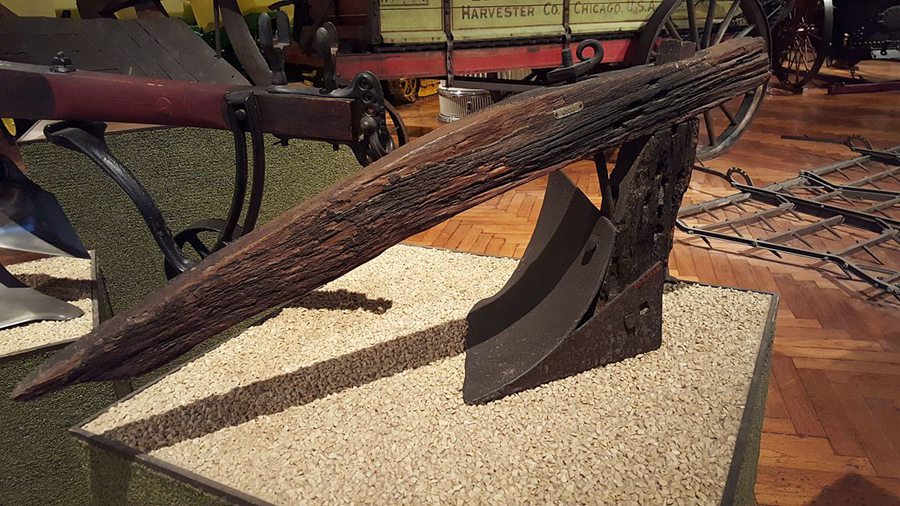
John Deere is one of the most renowned manufacturers of antique plows. Founded in 1837, the company quickly established itself as a leading producer of farm equipment. Many of their antique plows, crafted from iron and wood, are highly sought after by collectors due to their superior build quality and historical significance. Look for markings or plates featuring the John Deere name and logo to identify these plows.
Final Thoughts
When identifying and valuing antique plows, it’s essential to consider several factors to make an informed decision. By understanding the different types of antique plows, such as walking, animal-drawn, or tractor-drawn, you can start narrowing down your search.
You should pay close attention to key attributes like age, material, and brand. Older plows are typically more valuable due to the rarity, while plows made from durable materials like wood, iron, or steel may hold a higher value. Well-known manufacturers like John Deere or Oliver Farm Equipment Company can also increase the worth of an antique plow.
Your next step should be to assess the plow’s condition. Keep in mind that some restoration work might be needed, which could affect the value. Look for signs of wear, age, and any parts that might need replacement.
- Age: The older the plow, the rarer and potentially more valuable it is.
- Material: Wood, iron, or steel plows can hold a higher value compared to others.
- Brand: Renowned brands like John Deere or Oliver Farm Equipment Company can contribute to the value.
Finally, look for any historical ties attached to the antique plow. Sometimes a plow might have been owned by a well-known person or used during a significant event, which can considerably raise its value.
As you continue to explore the world of antique plows, your knowledge and ability to identify valuable pieces will grow. With practice and research, you’ll be well-equipped to make confident decisions about the antique plows that catch your eye. Good luck on your journey!
FAQ
How can I identify an antique plow?
To identify an antique plow, consider these factors:
- Material: If the body is made of wood, it could be an antique
- Blade shape: Antique blades are usually more curved than modern blades
- Handles: Examine the design and any markings on the handles
What factors impact the value of an antique plow?
Consider the following six factors when determining the value of an antique plow:
- Age and date: Early plows from the 1750s were basic in design
- Brand: Recognizable brands may increase value
- Materials: Original materials, such as wood or cast iron, can affect value
- Condition: Well-maintained plows are typically worth more
- Rarity: Less common plows may be more valuable
- Historical significance: Plows connected to significant events or locations might be worth more
What is the typical price range for antique plows?
The majority of antique plows range from $100 to $300. However, you may find models priced up to $700, or rare cases in which plows sell for thousands of dollars. A well-maintained, decent-looking plow might cost between $150 and $200.
What are some common antique farm tool types?
In addition to plows, other common antique farm tools include:
- Chaff cutter: A device for cutting hay, chaff, oats, and straw into short pieces before mixing them into cattle feed
- Grain cradle: A wooden or metal frame attached to a scythe to aid in cutting and gathering grain
- Potato digger: A tool for lifting potatoes from the ground
- Sickle: A hand tool with a curved blade used for cutting grain and other crops
- Seed drill: A machine for sowing seeds at a uniform rate and depth
How can I show off my antique plow collection?
You can display your antique plows as part of your outdoor landscaping, in a barn or shed turned into a museum, or take them to antique farm equipment shows for enthusiasts to appreciate. Just remember to take proper care of the plows to prevent deterioration from exposure to the elements.

